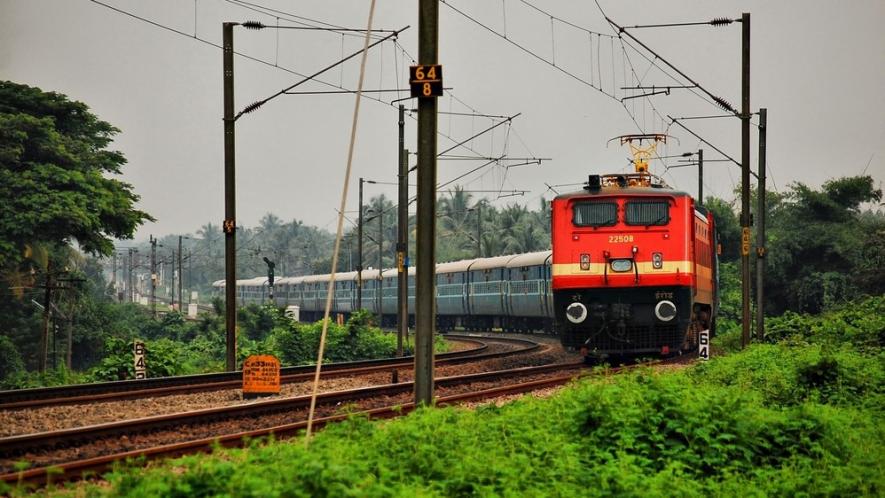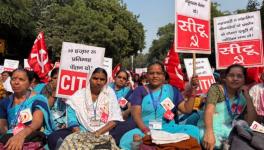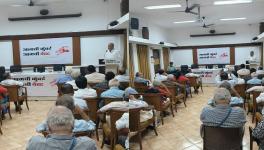‘BJP Govt’s Railway Budget Cut a Pointer Towards Privatisation’

The Union government seems to be moving further towards the privatisation of railways by cutting budgetary support to the Indian Railways by 27 per cent.
The Union government has cut the gross budgetary support (GBS) to the Indian Railways by Rs. 15,000 crore for the financial year 2017-18, Business Standard reported.
The GBS earmarked for the railways by the Union Finance Minister Arun Jaitley in the 2017-18 budget was Rs. 55,000 crore. But this is set to go down, with the Revised Estimates for the year being Rs. 40,000 crore, which means a 27 per cent cut on the budgeted amount, the report said quoting a person close to the development.
The Revised Estimates (RE) of gross budgetary support would be 13 per cent less than the RE of Rs. 46,350 crore for the 2016-17 financial year.
Sources also indicated that there could be a further cut to the tune of Rs.10,000 crore on the allocated amount, reducing the GBS for the year to Rs. 30,000 crore.
The Business Standard report said that the government, faced with a revenue squeeze, has told various departments that government support will have to be reduced for the current financial year. To meet the shortfall, the railways is not planning to resort to options including asset monetisation, market borrowing and institutional financing. The government had been planning to raise Rs. 30,000 this financial year through asset monetisation.
Newsclick spoke to R Elangovan, Vice-President of the Dakshin Railway Employees Union (DREU) affiliated to the Centre of Indian Trade Unions (CITU), on the implications of the budget cut.
“The railways wanted to get corporates to redevelop more than 400 stations,” Elangovan said. “Rs. 1 lakh crore was supposed to come to the railways in this manner, by leasing out railway land for the commercial utilisation by corporates. But no developer came forward, except for Habibganj station. They extended and extended the last date for opening tenders, to no avail. They initially said that the lease will be given for 45 years. They were ready to give it for 60 years, but even then nobody came forward. The programme has not materialised.”
The Union government had announced in July 2015 that it would redevelop 400 railway stations using the Swiss challenge method of giving contracts. “Any person with credentials can submit a development proposal to the government. That proposal will be made online and a second person can give suggestions to improve and beat that proposal,” Finance Minister Arun Jaitley had said.
“But now that developers are not coming forward for the redevelopment plan, the government wants to withdraw the Swiss challenge plan,” Elangovan said. “They want to float tenders and directly give it to the best bidder. But the changed policy has not yet been announced. As of now, the Rs. 30,000 crore they said they will raise through asset monetisation is going to be a chimera,” said Elangovan.
“Last year they had decided to invest Rs. 1,31,000 crore as capital expenditure in 2017-18. Rs. 65,000 crore was to come through extra budgetary resources (EBR), Rs. 55,000 crore was to be gross budgetary support, and the balance, from internal resource generation. But now with the cut in GBS, the Rs. 1,31,000 crore plan outlay cannot take place.”
“The total EBR includes market borrowing. As for market borrowing, they say that Rs. 22,000 crore will come from bond sales of the Indian Railway Finance Corporation (IRFC). And they expect Rs. 20,000 crore through insurance – LIC. There is an MoU with LIC, according to which the LIC would pump in Rs. 1,50,000 crore in five years. This means Rs. 30,000 crore has to come ever year. But the figures for the past three years are Rs. 17,000 crore, Rs. 20,000 core and Rs. 20,000 crore respectively. So the expectation that there would be so many takers for investment with such long gestation period also has not materialised to the extent that they expected.”
“The 12th Five-Year Plan was wound up by this government. They started their own Five-Year Plan for railways, with Rs. 8,56,000 crore planned as investment for five years. That would have meant Rs. 1,71,000 crore every year. But in the first year they planned to invest Rs. 1,00,000 crore, in the second year, Rs. 1,24,000 crore and in the third year – the current year – the plan was for Rs. 1,31,000 crore. In 2018-19 they want to invest Rs. 1,46,000 crore. But they are not meeting their own plan outlay targets.”
“Even out of Rs. 1 lakh crore planned for the first year, they could spend Rs. 93,000 crore only. In the second year, out of the planned Rs.1,21,000 crore investment, only Rs. 1,05,000 crore was spent because the expected PPP mobilisation did not take place.”
“Now this year, with the cut of Rs. 15,000 crore GBS, the plan outlay has been reduced from Rs. 1,31,000 crore to Rs. 1,06,000 crore. They won't even meet last year's allocation.”
“And Piyush Goyal is saying that he is not bothered, that there are other ways of mobilisation. That is imaginary. He is only planning a train without wheels; it will not reach its destination.”
Elangovan said that the budget cut is part of larger thrust towards privatisation of the railways in India.
“Hitherto train operations had not been privatised. But as per the Bibek Debroy Committee recommendations that the government has accepted, they are going to appoint a Railway Development Authority,” he said.
“According to the concept paper released by the Railway Minister, the RDA will be empowered to permit "fair access" or "level playing field" to the private operators. The Ambanis and the Adanis will be allowed to run trains on tracks that are already congested. Development programmes have not been undertaken, expansion hasn’t taken place, and there is already 100-150% occupation in most lines. And the private operators will be allowed to run trains on the same tracks. They will be given a “level playing field” – to start with, the private sector will be allowed to operate 50% of the trains.”
“The fare, freight charges, and time-table will be decided by the RDA. Privatisation is on the cards. This will be done this year itself – RDA vacancies were notified for filling them up. Applications were called for – 15 November 2017 was the last date. RDA is going to be a reality, after which privatisation will take place. Thus the necessity for more budget allocation for more coaches, more wagons and so on will not arise.”
“The case of filling vacancies is also similar. The Railway Minister has said in his reply to a question raised in the Parliament that he is not going to fill up safety category vacancies. There are 1,41,000 safety category vacancies as on 31 October 2017, according to reply in the Parliament. Only 50% of the vacancies will be processed for filling up.”
“They are now recruiting retired employees. The Minister’s reply in Parliament said that filling up safety category vacancies will take a long time since the number of vacancies is large. There are 2,22,000 vacancies in total as on 1 April 2017. They are not going to fill up these.”
“Once 50% of the trains are run by the private sector, naturally 50% of railway staff will become surplus. There are 17,000 vacancies of drivers and 40,000 vacancies of gangmen. If they fill up the vacancies now, once privatisation has taken place, young people will become surplus. They are not willing to fact that problem. So they are not going to fill up the vacancies, even safety vacancies. They are recruiting retired employees to fill the gap; once they are not required, they can be discharged any time. In Southern Railway alone, 5000 vacancies are being filled through retired employees.”
“Apart from pushing forward the privatisation agenda, the cut in gross budgetary support would adversely affect safety,” he said. Arun Jaitley had set up a special safety fund with a corpus of more than Rs 1 lakh crore over a period of five years in the 2017-18 Union Budget. Following the cut in GBS, government sources have claimed that the shortfall due to the budget cut would be made up through extra-budgetary resources.
“The hopes that extra-budgetary resources can compensate the shortfall are imaginary,” Elangovan added.
Get the latest reports & analysis with people's perspective on Protests, movements & deep analytical videos, discussions of the current affairs in your Telegram app. Subscribe to NewsClick's Telegram channel & get Real-Time updates on stories, as they get published on our website.
























